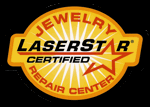Laserstar® Welder Jewelry Repair

We have the only LaserStar welder for jewelry repair in Medford Oregon
LASER WELDING VS. SOLDERING
There are many different reasons why laser welding is
superior to soldering; one application that best describes many of these reasons is the process of ring sizing. To better
understand the differences, we must first look closely at the two processes.
Soldering,
or more appropriately brazing, is a capillary fill system where
solder is heated with a gas oxygen torch, or open flame. The solder
then flows across and bridges the noble metals together. Solder
is an alloy that is designed to melt at a lower temperature than
the noble metal one is soldering; therefore, it is a different alloy
than the noble metal. The heat used for this process is very high,
and thus often results in a visible seam, discoloration, or fire
scale in the solder area.
Laser welding is a process in which light energy is used to
weld the noble metals to themselves; this process fuses the noble metal on a molecular level resulting in a finished product
that is all one alloy. When adding metal or “filler wire” with the laser welder; we will almost always add the same noble
alloy. The heat used in the welding process is so localized that it results in a seamless, undetectable work zone that is
not discolored in any way.
When soldering with a torch, the heat is applied to a
relatively large area resulting in heat transfer. If the user is not careful, he can burn or destroy heat sensitive stones
and other heat sensitive materials that are in close proximity to the flame. The jeweler is forced to either remove these
stones or protect these areas with a heat absorbing substance.
The laser has a finely focused beam resulting in a minimal
heat-affected zone or “bombardment zone.” During the welding process, the metal adjacent to the bombardment zone does not
become molten. This precision heat source allows the user to weld metal in close proximity to heat sensitive stones and
materials such as epoxy, enamel, pearls, and stringing thread to name a few, without affecting the stone or material.
Because of this pinpoint heat source, the laser will not anneal springs or clips eliminating the need to replace damaged
findings.
When soldering,
steps must be taken prior to and after the heating process. One
step is to thoroughly clean the ring of any dirt or oils from it’s
surface. To reduce the amount of fire scale; the user must also
coat the ring with a mixture of boric acid and denatured alcohol
prior to soldering. This mixture must later be removed by pickling.
When laser welding, the beam is so concentrated, it burns
away any impurities during the welding process, thus eliminating the need for prior cleaning, coating and post-pickling
processes. Laser welding can be performed on dirty or even tarnished surfaces without leaving discoloration or fire
scale.
|







